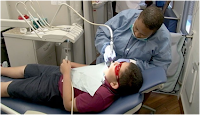By Michael Monopoli, DentaQuest Foundation Director of Policy and Programs
Part of the challenge in changing the dental delivery system and expanding access is that too often, people don’t have access to continuing care in a way that maintains oral health. The DentaQuest Foundation is focused on educating people about the centrality of oral health to overall health.
Dental disease isn’t usually top of mind in the national conversation about health care. However, it is a serious, chronic, infectious illness—and it is preventable. Consider this:
- Dental disease (cavities) is the most common chronic disease in children, more common than asthma.
- Every year across the United States, children miss 52 million school hours due to dental disease. Adults lose close to 164 million work hours.

- In 2010, Americans spent $106 billion on oral care.
Part of the challenge in changing the dental delivery system and expanding access is that too often, people don’t have access to continuing care in a way that maintains oral health. The DentaQuest Foundation is focused on educating people about the centrality of oral health to overall health.
Through a series of grants, the foundation is doing all it can to fix this problem and promote good oral health. Most recently, the foundation announced that five additional state/regional primary care associations (PCAs) have been selected to participate in the Strengthening the Oral Health Safety Net Initiative, a national program instituted in fall 2011 to promote oral health access at community health centers (CHCs) across the country. In total, the initiative engages 10 state/regional PCA partners to develop their capacity to provide oral health leadership and technical assistance to safety net programs in their states.
CHCs are America’s health safety net, serving 23 million patients in more than 8,000 communities. They provide preventive and primary health care services to people that face financial, geographic, language, cultural, and other barriers to receiving care. The grants will promote oral health leadership, develop oral health expertise, encourage collaboration among dental and medical programs, and advance safety net oral health needs at the state level. Each award consists of grant funds plus direct practice improvement technical assistance for safety net dental programs provided in-kind by the Safety Net Solutions team of the DentaQuest Institute, a nonprofit organization affiliated with the DentaQuest Foundation.
But, it’s the ripple effects of these initiatives that are critical. When communities work together, powerful change can happen, which is why we are excited to welcome these five new PCAs to the Strengthening the Oral Health Safety Net Initiative. Together, we can change how people respond to a preventable disease.
























